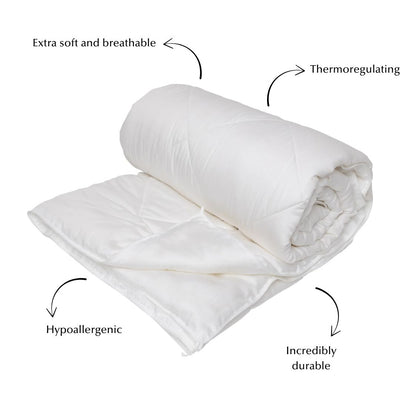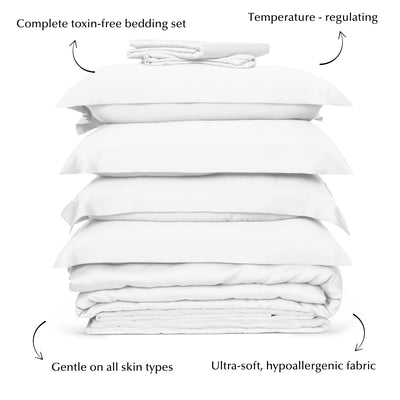Making environmentally-friendly buying choices isn’t always as simple as it should be, with some companies tricking consumers by ‘greenwashing’.
As a result, sometimes, your eco-friendly choices turn out to be not as beneficial to the environment as you first thought! But what is greenwashing exactly, and how can we combat it?
In this article, we’ve defined greenwashing and explained what it is in business, outlined why it’s a harmful practice, and provided ways you can spot greenwashing companies and combat their unethical actions.
By understanding greenwashing, you’ll have the tools to hold culpable businesses accountable and make sure your money is going towards ethical and eco-friendly companies.
What is greenwashing in business?
Greenwashing refers to companies, brands, and individuals attempting to create the false impression that they are more environmentally-conscious than they truly are.
Since concepts like sustainability and eco-friendliness are increasingly seen as attractive qualities, companies capitalise on consumer’s’ good intentions by deceiving them into believing they are their products are ‘green’.
Companies create a green image by suggesting that they are, among other things, more natural, healthier, and less wasteful than competitors.
Greenwashing can take many forms. Sometimes it can be blaringly obvious, while other times it can insidiously infiltrate the public’s perception of a brand. However, companies regularly get away with greenwashing by manipulating their marketing, advertisement, and social media tactics.
The problem is that, a lot of the time, energy and money goes towards convincing consumers of the company’s ‘greenness’, rather than making any significant effort to doing the work that actually makes their products, processes, or services better for the environment.
Ultimately, if a company cares more about using a green image to increase their profits rather than actually attempting to benefit the environment, it will likely be guilty of greenwashing.
Why is greenwashing harmful?
There are a number of reasons as to why greenwashing could be considered harmful, so we’ve picked out two you should be aware of:
Of course, one of the most important is that companies are masquerading as sustainable, when in reality they’re doing very little to combat eco issues, and may even be contributing to unethical practices.
This leads into our second point: greenwashing is misleading and deceitful, and encourages customers to act unethically against their will and better judgement. Greenwashing may lead eco-conscious customers to support products and brands that don’t actually align with their values.
Each time a consumer unwittingly spends money at an unethical business, an eco-conscious company loses out – and so, subsequently, investment into environmental initiatives is reduced.
Businesses who greenwash and trick customers to purchase from them instead of legitimate green companies are in-part responsible for the slow growth of eco-friendly projects.
Where did the term ‘greenwashing’ come from?
The term ‘greenwashing’ was first coined in 1986 by American environmentalist Jay Westerveld, who contested hotels’ reasoning behind asking guests to reuse towels and bedding. While the concept of reusing towels is beneficial, nowhere else in the hotel’s operations and services were there any efforts to benefit the environment.
Rather than an environmental initiative, Westerveld believed it simply to be a strategy to reduce work and save on laundry costs. He claimed that hotels were displaying themselves as eco-conscious, when the goal was, in fact, to simply engineer further profit.
‘Greenwashing’ was subsequently added to the Oxford Dictionary just over a decade later, in 1999, and has been widely used across all forms of media since. It defines greenwashing as any information that falsely presents an environmentally-responsible image.
Examples of greenwashing
So, we now know what greenwashing is, but have there been any high-profile examples of greenwashing? Of course! We’ve picked out a couple of recent greenwashing examples.
- Nowhere else in the hotel’s operations and services were there any efforts to benefit the environment. While the concept of reusing towels is beneficial to the environment, the hotel used it as a front to reduce their laundry costs.
BP’s carbon footprint calculator
One of the most manipulative greenwashing examples is BP’s creation of the customer carbon footprint calculator.
While BP were busy drilling for millions of barrels of oil, they encouraged their customers to figure out how to change their lifestyle to reduce their impact on the environment.
This sly campaign took the limelight off BP’s environmental transgressions, and instead put the blame on the consumer. Individual actions are an important part of fighting climate change, but significant environmental impact comes overwhelmingly from large and powerful corporations like BP.
H&M’s conscious collection
Most major clothing brands are guilty of fast fashion crimes; however, few have been under as much spotlight as H&M. The retail giant has thousands of stores across the world, selling a huge amount of clothes at relatively cheap prices.
H&M released a ‘conscious collection’ line of clothing, claiming that every piece is made from recycled or sustainably sourced material.
Unfortunately, critics have pointed out that some of the ‘sustainable’ materials chosen take as much energy to produce as unsustainable options. Additionally, clothing labelled as recycled only contains up to 50% recycled material -, less in many cases.
The fashion industry is home to some of the biggest culprits of greenwashing. From the environmental impact of the fabrics used to the working rights of the garment manufacturers, fast fashion has a lot to answer to.
One of the simplest ways to opt out of fast fashion is to buy products that are designed to last for a long time. Additionally, opt for genuinely sustainable fabrics with verified methods of production such as Tencel™.

Shop Ethical Bedding's environmentally friendly Tencel Ultimate Bedding Bundle Set
Why do companies greenwash?
Companies that use greenwashing are focused solely on the profit. They believe that marketing a product as sustainable or ethical will convince more people to buy it, or allow them to sell it at a higher price.
This belief is supported by studies such as the Nielson’s Global Corporate Sustainability report, which shows that 66% of consumers are willing to spend more on a sustainable product. This figure rises to 73% in Generation Z shoppers, indicating an increasing future demand for sustainability.
Companies see this trend, and can either decide to make sustainable and ethical products or create the illusion of ethical products.
Unfortunately, many businesses often choose the path of greenwashing, meaning they opt for quick marketing fixes over long-term ethical practices; pretending to be sustainable is almost always easier for brands to pull off, as it’s much cheaper than committing to sustainability and has a big pay-off!
How to spot greenwashing
Greenwashing companies are clever. Using marketing ploys and advertising techniques, they can easily manipulate consumers into believing their products are green. So, savvy customers need to know what to look out for.
Unchecked use of ‘eco’ terms
One of the reasons greenwashing is so convincing is because of the unchecked use of terms like ‘eco-friendly’, ‘green’ and ‘sustainable’. There are no legal definitions of terms like these, which allows companies to use them as they like , without having to provide proof to back them up.
A lack of data to support claims
To separate green products from greenwashing, look for facts and data to back up these terms. If a product is labelled ‘natural’, look for the ingredients that substantiate this claim. If a company claims sustainability, ignore them unless they outline how exactly their operations or materials are sustainable.
A lack of certification
Even the term 'organic’ should be questioned. If a product genuinely contains organically grown materials, they will have the certifications to back it up! And make sure you know your certifications. Some companies make up their own certifications and plaster them across their products, when in reality , these endorsements are meaningless.
Navigate confusing and complicated jargon
Another greenwashing tactic involves using complicated jargon or meaningless expressions that only experts could understand. These companies rely on confusing terminology, so that customers don’t know exactly what they are buying and assume ‘greenness’ from images and packaging.
Be aware of suggestive imagery and labels
It’s not just language that pedals greenwashing. Brands will also use suggestive images, labelling, and product naming to evoke a green and environmentally responsible façade. It’s important to look beyond the marketing of a product and find the facts.
Explore hidden trade-offs
Be aware of companies that market themselves as ethical and sustainable, but can’t back up the claims across other actions.
For instance, they might sell a product that is made from mostly recycled plastic, but have failed to reduce their carbon emissions, or transport manufacturing materials halfway around the world. They’ll focus on the eco-friendly aspect, while ignoring the rest.
Research the human cost of production
It’s important to acknowledge that ethical practices extend beyond the type of materials used in production. For instance, a company may be greenwashing to draw attention away from the way they treat their workers.
There are businesses around the world who continue to underpay potentially vulnerable staff and place them in unsafe working conditions, while parading a new eco-conscious product line to improve brand perception.
Consider the company background
When considering whether a product is greenwashed, it helps to look at the overall behaviour of the company selling it. If it seems strange that an oil company is selling ‘sustainable’ products, that’s because it is!
The products are an attempt to stay in public favour without having to do any real work towards sustainability.
You can spot the greenwashing of a company or brand by looking at the reasons behind their actions.
If a company does a grand gesture to benefit environmental causes, are they doing it because they care or because they want to hide their environmental impact? Similarly, are environmental decisions made proactively or are they done for selfish reasons like keeping their customer base pleased?
Greenwashing vs green marketing
As the demand for less environmentally- damaging products increases, so does the amount of more genuinely sustainable and eco-friendly products. These products are entering the market place just like any other, and need to be marketed and advertised in order to sell.
The question is: how can the consumer tell the difference between greenwashing and green marketing of products and brands?
Luckily, there are a few key signs to look out for that can prove the legitimacy of a green company selling a sustainable brand or product:.
- - The brand is often open and honest about how they operate. On websites, labels, and packaging, there is likely to be clear information in plain language that explains how the product was made and how it got into your hands.
- - Any environmental or sustainability claims are backed up by facts, details, and data. Remember, truly ‘green’ companies want to prove their legitimacy while greenwashed brands try to cover it through a green smokescreen.
- - Look for industry recognised certificates and government backed standards. If the materials the product is being made from are genuinely sustainable, there will be certifications to prove it.
- - Check the packaging! Green brands will extend their values to their product packaging, limiting the amount of packaging used and using recycled/recyclable materials.
- - Check how the product will be disposed. Is this product designed to last for a very long time? Can it be repaired rather than replaced? Is it recyclable? If a brand genuinely wants to create a green product, they will focus on how that product will affect the earth after it has passed its use by date.
What are the dangers of greenwashing?
So, why is greenwashing such a big problem? First of all, companies should be held accountable for their attempts to deceive consumers. However, greenwashing can have much more widespread and damaging effects.
When brands convince consumers to buy their greenwashed products, and customers subsequently find out that their socially conscious efforts have been in vain, it can cause a distrust of green marketing that damages the legitimacy of genuine eco-conscious brands and products.
Consumers that buy greenwashed products are doing so because they believe their money is going towards a cause they believe in. Greenwashing redirects cashflow from legitimate sustainable and ethical green companies, and instead sends it to businesses that don’t actually help to benefit the environment.
Things you can do about greenwashing
When it comes to detecting and fighting greenwashing, knowledge really is power. Once you know what to look out for when it comes to separating green products from greenwashing, you can vote through your consumer choices and go for genuinely green brands.
Ask questions before buying
If you’re unsure whether a company is sustainable or eco-conscious, start asking questions. One of the best places to begin is starting a conversation with the brand on social media, quizzing them on eco-practices.
Not only will the brand likely be quick to respond if they have the data and certification to back up their statements, but you’ll be alerting other consumers to any dubiousness if not.
Choose sustainable products
Driving up the demand for sustainable and ethically made products is a certain way to ensure their prevalence in the market is secure and increasing.
Whenever possible, no matter what you’re buying, try to opt for the more sustainable option from eco-friendly companies. You may not think your individual choice has much impact overall, but as more and more people choose sustainably, green companies will become more accessible and prevalent.

Shop Ethical Bedding's natural, organic eucalyptus silk pillowcases
Spread awareness
Word of mouth has always been a powerful tool for spreading information. And with social media, that voice is amplified.
If you hear about a company that has been greenwashing their brand or product, spread awareness and hold these companies accountable.
Social media and exposure can also be a great way to amplify and advertise your favourite brands and products that are actually green, as well as eco-friendly companies. The more people who know about genuinely sustainable and ethical products, the more popular they will become!
Read about our mission to combat greenwashing, as well as our commitment to sustainable and ethical practices at every stage of the manufacturing journey.
You can also discover our all natural and sustainable bedding bundles all-natural & sustainable bedding, as well as even more from our experts over on our blog. .




















